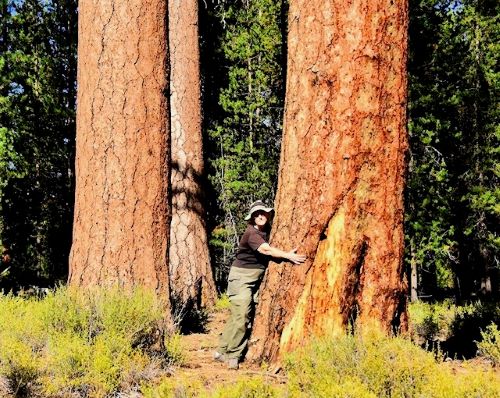Meet our new Habitat Haven volunteer. Evelyn Sherr has joined Lane Audubon’s Habitat Haven Backyard…
Dave Stone
When Europeans first set foot in North America, it is estimated that there were 500,000 Bald Eagles on the continent. Their nests lined the rivers, circled large lakes, and occupied our coastal areas.
Celebrating the 40th Anniversary of the Endangered Species Act: Bald Eagle Recovers!
Dave Stone
When Europeans first set foot in North America, it is estimated that there were 500,000 Bald Eagles on the continent. Their nests lined the rivers, circled large lakes, and occupied our coastal areas.
Many Native Americans considered (and still do) the Bald Eagle, along with the Golden Eagle, to be sacred, and used its feathers in religious ceremonies, believing Bald Eagles to be spiritual messengers between gods and humans. Current laws allow qualified Native Americans to possess eagle feathers for use in religious ceremonies.
Bald Eagles were so revered by the colonists that the bird was adopted as a symbol of America in 1782, representing strength and freedom. Lewis and Clark reported the first Oregon observation in 1805. By 1963, however, Bald Eagles had declined to 416 pairs in the lower 48 states. In 1967 the Bald Eagle was declared an endangered species.
After nearly 200 years as the symbol of America, how did it come to this? Indiscriminate hunting, habitat loss, the feather trade, and competition with humans for food took a heavy toll on their population. The introduction and subsequent widespread use of the pesticide DDT accelerated the decline.
The decline first began to be recognized in the mid-1900s. Several laws were passed in the 20th century that contributed to the Bald Eagle’s comeback:
The Lacey Act of 1900—This was the first federal law to regulate commercial animal markets and included the Bald Eagle. It prohibited interstate commerce of animals killed in violation of state game laws and protected all nongame fish and wildlife and their parts or products.
Migratory Bird Treaty Act (MBTA) of 1918—The MBTA prohibits the taking, killing, possession, transportation, and importation of migratory birds (including the Bald Eagle), their eggs, parts, and nests except as authorized under a valid permit.
Bald and Golden Eagle Protection Act of 1940—This Act provides for the protection of the Bald and Golden Eagles (as amended in 1962) by prohibiting the “take, possession, sale, purchase, barter, offer to sell, purchase or barter, transport, export or import, of any bald or golden eagle, alive or dead, including any part, nest, or egg, unless allowed by permit.” To enable Native Americans to continue their traditional practices, the Bald and Golden Eagle Protection Act allows the U.S. Fish and Wildlife Service (USFWS) to issue a permit to qualified members of Indian tribes to acquire Bald Eagles or Golden Eagles, or their parts, nests, or eggs for Indian religious use except for live Bald or Golden Eagles, or any live eggs of these birds.
Land and Water Conservation Fund Act (LWCFA) of 1965—Habitat needs were first recognized when a provision was added in the LWCFA to provide money for the “acquisition of land [and] waters … for the preservation of species of fish and wildlife that are threatened with extinction.”
The Endangered Species Preservation Act of 1966—Predecessor of the Endangered Species Act, this act authorized the Secretary of the Interior to list endangered domestic fish and wildlife (including the Bald Eagle) and allowed the USFWS to spend up to $15 million per year to buy habitats for listed species.
The Environmental Protection Agency Ban on the General Use of DDT, 1972—The widespread use of the pesticide DDT was found to cause Bald Eagle eggs (and those of many other bird species) to become so thin that they broke during the incubation process, accelerating the already rapid decline of the Bald Eagle population.
Endangered Species Act (ESA) of 1973—Bald Eagle populations (and those of other species) continued to decline. Clearly, the existing laws were inadequate, so Congress passed what the Endangered Species Coalition calls an “incredibly effective (law to) protect the fish, plants and wildlife that are listed as endangered or threatened.” (See the April 2013 issue of The Quail for a full discussion of the provisions of the ESA.)
Recovery of the Bald Eagle
Many actions led to the recovery of the Bald Eagle, including the banning of DDT and the implementation of an effective recovery plan, which included a captive breeding program, reintroduction, and habitat and nest protection, as well as law enforcement. As a result, the Bald Eagle was taken off the Endangered Species List in June 2007. At that time, there were more than 9,700 nesting birds in the lower 48 states.
You can see a breeding pair of Bald Eagles right here in downtown Eugene in Skinner Butte Park. Go to the top of the Butte and take the northern loop of the paved trail. The nest is in the trees to the north of the trail. On any sunny afternoon, you are likely to find a birder or two who can point out the nest (and chicks in the spring!).
The Future of the Bald Eagle
Bald Eagles are still protected under the Lacy Act, Migratory Bird Conservation Act, and Bald Eagle and Golden Eagle Protection Act. The Recovery Plan provides for continued monitoring of the Bald Eagle population and authorizes the USFWS to prevent significant threats from driving it back toward extinction.
Resources:
Bruce E. Beans, Eagle’s Plume: The Struggle to Preserve the Life and Haunts of America’s Bald Eagle, 1996 (available at the Eugene Public Library)
http://www.fws.gov/midwest/eagle/protect/laws.html
http://www.fws.gov/midwest/eagle/recovery/qandas.html



